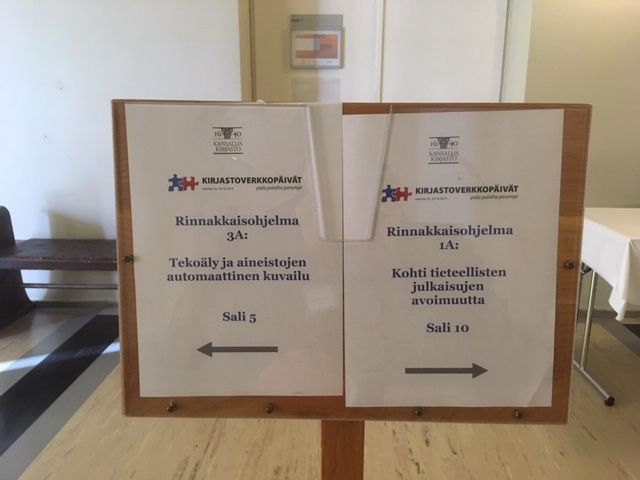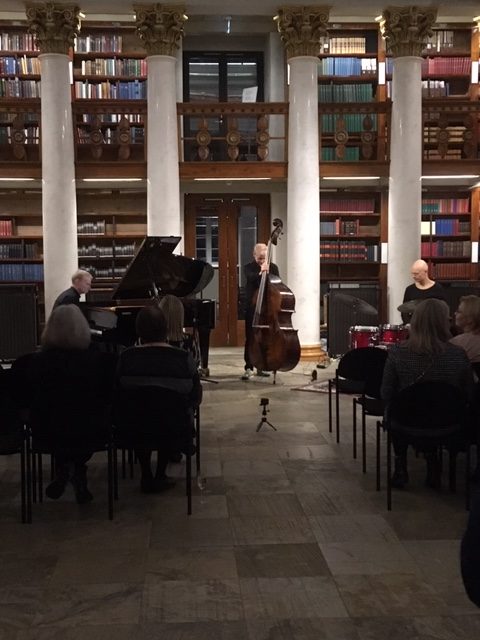Pala palalta parempi – Kirjastoverkkopäivät 2019 | Incremental Improvements – Library Network Days 2019
(Please scroll down to read in English.)
Kansalliskirjaston joka toinen vuosi järjestämille Kirjastoverkkopäiville kokoontui tänä vuonna yli 500 kirjastoalan ammattilaista. Tämän kertaisten Kirjastoverkkopäivien alkupalaksi Monica Crump Irlannin kansalliskirjastosta esitti innostavan puheenvuoron kirjastojen tulevaisuudesta. Hän näki, että kirjastotieteen yhden “isän” S. R. Ranganathanin lait eli kirjastotieteen peruspilarit pätevät edelleen. Perinteisen kirjan sijasta hän käyttää kuitenkin laajempaa kaiken tyyppistä sisältöä (content), johon Ranganathanin lakia voidaan soveltaa. Crump kannattaa todellista avointa julkaisemista, jossa kirjastot eivät maksa lisämaksua tieteellisten artikkeleiden avoimesta julkaisemisesta eikä hänen mielestään tutkijoille pitäisi tulla lisätehtäviä tms. liittyen artikkelin avoimeen julkaisemiseen – ”save the time of the reader/author”. Erityisesti mieleen jäi hänen neuvonsa kirjaston asiakaspalvelijalle: “Be a friendly, supportive face in the anonymity of the digital world” sekä hänen mainitsemansa IFLAn Global Vision raportista poimittu kohta sisällön säilyttämisestä tulevaisuuden lukijoille: ”we are the guardians of the memory of the world”.

Tiedon paloja rinnakkaisohjelmista ja työpajoista

Päivä 1
Tekoäly ja aineistojen automattinen kuvailu -osiossa kuultiin tekoälykumppanuudesta, jossa CSC, Kansalliskirjasto ja Kansallisarkisto tekevät yhteistyötä tekoälyn hyödyntämisessä. Projektin lopputuloksena saatua dataa tullaan julkaisemaan avoimesti (lisätietoa tekoälykumppanuudesta).
Toinen puoli osiota esitteli automaattisen sisällönkuvailun työkalun Annifin tulevaisuuden näkymiä sekä miten Annifia käytetään pro gradujen sisällönkuvailun apuvälineenä Jyväskylän yliopistossa. Annifista on tällä hetkellä käytössä jo sen toinen versio, joka toimii huomattavasti paremmin kuin proto-versio. Annifin käyttöä sisällönkuvailun apuvälineenä gradujen lisäksi tullaan käyttämään tulevaisuudessa myös uusien väitöskirjojen kohdalla. Osma Suominen kertoi, että tulevaisuudessa Annifin laatua parannetaan, siitä julkaistaan tuotantokäyttöön sopiva rajapinta, se otetaan käyttöön Kansalliskirjaston järjestelmissä ja sen kansainvälistä käyttäjäyhteisöä laajennetaan.
Iltapäivän rinnakkaisohjelmista kiinnosti tietysti erityisesti Almaan liittyvät integraatiot koska Alma otetaan käyttöön myös Itä-Suomen yliopiston kirjastossa tämän vuoden vaihteessa. Finnan kohdalla integraation tilanne 21.10.2019: kaikki kunnossa. Melindan Alma-integraatiota työstetään parhaillaan. Tiedetään, että Asterin toimija-auktoriteetit ovat käytettävissä Alma-kuvailussa. Myös Finton sanastoista YSO, YSO-paikat ja SLM ovat käytettävissä Almassa.
Ensimmäisen päivän iltapäivän päätti paneelikeskustelu, jossa aiheena oli Kirjastojen matka vuodesta 2020 vuoteen 2030. Panelistien mielenkiintoisessa keskustelussa puhuttiin mm. mitä asioita ottaisi ja mitä ei mukaan tästä ajasta vuoteen 2030.

Päivä 2
Korkeakoulukirjastojen tulevaisuuden tilastointitarpeet-työpajassa keskusteltiin monipuolisesti tulevaisuuden tilastointitarpeista, sillä nykymuotoinen tilastointi päättyy vuoteen 2020. Tilastointia tarvitaan myös sen jälkeen, joten yhteinen tavoite on luoda ”Tulevaisuuden tilasto”, KITT2030. Työpajassa keskusteltiin yleensä, mitä tilastoja tarvitaan? Mikä on ”pakko” ja mikä on ”suotavaa” tilastoida. Tilastokeskuksen ja OKM:n tarvitsemien kansallisen tason tilastotietojen lisäksi kirjastot tarvitsevat itse tietoa vuosikertomukseen ja toiminnan suunnitteluun. Nykyään KITT2:een kerätään yli 600 lukua, joista tilastokeskukselle menee reilu 100 ja OKM:lle pari lukua. Yhtenä ongelmana on ollut se, että juuri mitään lukua ei ole karsittu vuosien saatossa pois. Tiedot kokoelmista, lainauksesta ja rahoituksesta muodostavat kirjastotilastojen ytimen, mutta on myös uudenlaisia tilastointitarpeita, miten saada esim. asiakaskokemus mukaan tilastoihin? Tätä varten voidaan kehittää työpajan vetäjän, Markku Laitisen mukaan uudenlaisia tulevaisuuden indikaattoreita, ”yhdistelmäindeksejä”, jotka voisivat koostua useammasta kuin yhdestä osaindikaattorista.
Tilastolukujen saaminen on kirjastoissa vuosittainen iso ponnistus. Siirtymiset uusiin kirjastojärjestelmiin kuten KOHAan ja Almaan vaativat tietokantojen rakenteisiin tutustumista myös tilastoinnin näkökulmasta. Työpajan alussa Anneli Österman esitteli meille KOHA-järjestelmän tilastointia.
Automaattinen kuvailu: Aaveita koneessa -työpajassa pääsivät osallistujat arvioimaan aineistoihin liittyviä asiasanoja, joita oli tuotettu Annifilla ja/tai ihmisen voimin. Kuten ensimmäisessä Annifin ja ihmisen kohtaamisessa myös tässä toisessa kohtaamisessa ihmisen tuottama sisällönkuvailu oli laadukkaampaa. Tosin Annif on kehittynyt niin, että sen käyttöä sisällönkuvailun apuvälineenä voi jo harkita vakavasti.
Melindan tutut konstit ja uudet metkut -työpajassa oli esillä mm. Melindassa käytettävissä olevat työkalut: Merge, Muuntaja ja Cyrillux.
Kirjastoverkkopäivät olivat onnistuneet. Mukana kotiin tuli uusia asioita hyödynnettäväksi omassa työssä. Mieleen jäivät isot muutokset, joiden keskellä olemme nyt – julkaisujen saattaminen avoimiksi, tekoälyn tuomat mahdollisuudet, uudet kirjastojärjestelmät ja uudistuvat tilastot. Monenlaisia paloja näiden lisäksi ehtii vielä tulla matkalla kohti vuotta 2030.

This year, the biennial Library Network Days (Kirjastoverkkopäivät in Finnish) organised by the National Library of Finland drew more than 500 library professionals. The 2019 Library Network Days kicked off with an inspiring talk about the future of libraries by Monica Crump from the National Library of Ireland. She posited that the Five Laws of Library Science put forward by S. R. Ranganathan, one of the fathers of library science, hold true to this day. However, instead of the book as the traditional library collection item, she spoke more broadly of all types of content to which Ranganathan’s laws can be applied.
Crump advocates genuine open publication wherein libraries would not need to pay extra charges for publishing scientific articles openly, and she finds that researchers should not be burdened with additional tasks and hurdles related to the open publication of their articles – “save the time of the reader/author.” Her advice to customer service staff at libraries was particularly memorable: “Be a friendly, supportive face in the anonymity of the digital world.” She also quoted a section from IFLA’s Global Vision report on retaining content for future readers, stating that “we are the guardians of the memory of the world.”
Nuggets of information from parallel sessions and workshops
Day 1
The portion on artificial intelligence and the automatic description of materials shed light on the partnership between CSC, the National Library of Finland and the National Archives of Finland to utilise artificial intelligence. The data generated by the project will be published openly.
The other half of the portion presented the future prospects of the Annif, tool for automated subject indexing and classification, and how it is used for indexing of master’s theses at the University of Jyväskylä. The second version of Annif, which is vastly improved over the proto version, is already in use. In the future, the Annif tool will also be used for new doctoral dissertations, alongside master’s theses. According to Osma Suominen, the functionalities of Annif will be further improved in the future, and a production-oriented interface will be created based on it and implemented in the National Library’s systems. The solution’s international user community will also be expanded.
As for the parallel programmes in the afternoon, the integrations related to Alma were naturally a draw, since the system will also be introduced at the library of the University of Eastern Finland at the turn of the year. Integration status for Finna on 21st October 2019: everything is in order. Melinda’s Alma integration is currently under way. It is known that the Asteri operator authorities are available in the Alma descriptions. Of the Finto vocabularies, YSO, YSO Places and SLM are also available through Alma.
The first afternoon concluded with a panel discussion on the path of libraries from 2020 to 2030. The fascinating discussion covered many topics, including what the panellists would take with them from today to the year 2030 and what they would leave behind.
Day 2
The workshop on future needs to collect statistics at the libraries of institutes of higher education entailed a diverse discussion on statistical needs in the coming years, as the current model for collecting statistics will be retired in 2020. The need for statistics will obviously not suddenly cease after that, which is why the common goal is to create a “statistical system of the future” – KITT2030. The workshop participants discussed what types of statistics are actually needed on a general level. What kinds of statistics “need” to and “should” be collected. In addition to the nationwide statistics required by Statistics Finland and the Ministry of Education and Culture, the libraries themselves need information for their annual reports and operational planning. At the moment, more than 600 pieces of data are being collected into KITT2, of which more than 100 are relayed to Statistics Finland and a few to the Ministry of Education and Culture. One of the problems has been that very few figures have been trimmed out over the years. Information regarding collections, loans and funding form the core of library statistics, but there are also new kinds of statistical needs, such as how to represent the customer experience in statistical form. According to Markku Laitinen who helmed the workshop, new kinds of indicators – “compound indices” – consisting of multiple part indicators could be developed for the purpose.
The annual compilation of statistics is a considerable effort at libraries each year. Transitions to new library systems, such as KOHA and Alma, require the database structures to be examined from a statistical perspective. At the beginning of the workshop, Anneli Österman introduced us to the compilation of statistics in the KOHA system.
Automated metadata: In the “Ghosts in the Machine” workshop, participants got to evaluate content-related keywords that had been generated through Annif and/or staff effort. As was the case the first time Annif and library employees were pitted against each other, the quality of the metadata created by actual people was higher. However, Annif has developed enough that its use as a tool to support automated indexing and classification can be considered in earnest.
The “Melinda’s familiar traits and new quirks” workshop presented the tools available in Melinda, such as Merge, Convert and Cyrillux.
The Library Network Days were a success. The participants took home new lessons and ideas to utilise in their own work. Among the notable topics were the massive changes we are currently tackling: open publication, the opportunities provided by artificial intelligence, new library systems and updated statistics. That being said, many additional pieces will be added to the puzzle on our way to 2030.
Anu Eskelinen, tietoasiantuntija | Information Specialist
Verkko- ja julkaisupalvelut | Library IT and publishing services
Tarja Turunen tietoasiantuntija | Information Specialist
Tietoaineistopalvelut | Collection services